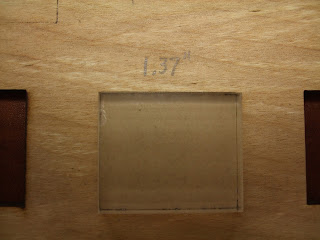Yesterday I used the 4 inch focal length laser to scan a small inch square rosebud image. The image was cropped out of a larger botanical drawing by my mother using colored pencils.
Grayscale modified rosebud
single and triple scanned rosebuds in cast plexiglass
edge view of the single scanned rosebud
edge view of the triple scanned rosebud - a deeper etch.
Number of scans
One etch was scanned once and another one was scanned 3 times. The difference in depth is quite noticeable, as the 3 times etched design is much more three dimensional, although it was also harder to clean debris from it. Debris was cleaned by compressed canned air while the material was in the chamber and by a wet stiff toothbrush in a sink afterwards. I observed that compressed canned air was more effective at loosening and blowing away debris from the crevices of a 3 by 5 inch etch from last week than yesteray's 1 inch square etch.
Bed positioning
I experimented with mounting the cast plexiglass both towards the center, and also on the far right edge of the support bed, to the right of the ventilation holes. I found that considerably less plume debris was deposited on the untreated plexiglass surfaces if the material was more towards the center. I also observed that cut throughs induced orange flames were much longer when the material was to the right of the ventilation holes. I failed to take photos of the flame, and central bed position. The flames were often as long as my index finger without proper ventilation. The pictures will show you the differences on the plume debris deposited on the surface areas.
Plexiglass positioned away from reach of ventilation holes underneath the support bed
Laser head range
The farthest that the laser head can move back is slightly off the edge of the bed so that the positioning red light is no longer visible. Whether it's acceptable to run the head to its extreme position can be discussed in the lab with co-workers. It also appears that if you have the laser head moved into position far away from the previous origin, pressing the red ESC (escape) on the laser control pad appears to bring the laser and back to the previous working origin and halts there, but without actually running the file. This behavior of the escape key is not documented in the Operator's manual.
Laser head in resting position
Changing speed/power on the fly
If all you want to do is change the scan speed and power setting of a g-code file already loaded into memory, you do not need to return to your computer and regenerate that g-code file. On the main control screen of the laser, press Enter twice. Then presss the Z/U key to move up and down the editable speed and power fields. Once one is chosen as highlighted in blue, press the left arrow key to underline the numerical value you want to change. Then press the up and down keys of the laser keypad to cycle through the numbers zero to 9. After editing any field, press enter to save it. Press Enter again when done to return to the main menu. A feature of the on-board software is that after editing those parameters, the image on the view screen of your object goes blank. Fix this by pressing the File keypad button, reselect your g-code file from the list, press enter again, and the image thumbnail is again viewable. NOTE THAT THE NEW PARAMETERS ARE STILL IN PLACE; YOU HAVE
NOT RELOADED THE ORIGINAL FILE. You simply have woken up the image to become viewable again.
direction matters
When cutting through the plexiglass to get the actual art piece to drop out loose, I noticed that the smoothness and minimization of ridges was far better in the horizontal direction than the vertical direction. I guessed incorrectly that increasing the speed from 15 to 30 mm/sec might improve the overall smoothness of the edges at 70% power. However, doing so failed to cut through the 3/8 inch plexiglass. Since I did not want to increase power further, I reverted back to 15 mm/sec to get a proper cut-through and will accept the smoothness quality as is for now.
Chamber coordinate system
While the scan is running, I observed the X coordinate, Y coordinate and Z coordinate values flashing quickly on the viewscreen. X values increase left to right. Y values increase top to bottom. Z values are steady of course, as neither the bed nor the laser head moves vertically while firing. The Z values were always positive. I therefore surmise that the Cartesian coordinate system of the laser chamber is left-handed.
time efficiency
The software controlling the horizontal gimble of the laser head has been well engineered from a time usage point of view. The X coordinates routinely adjusted based on the number of times the laser would need to fire to etch. In a horizontal row where very few pixels need to be etched the laser head skipped moving through the blank areas left and right of the etchable pixels, saving time.
Laser etching the rosebud into the plexiglass
low powers
You can edit power levels down to as low as 0.1% on-board the laser, but numbers 0.9% or lower are rounded up to 1.0%. A large number such as 70%, if edited to for example, 70.4%, will be respected as such in the main menu. Setting values to 1% is good trick to get a layer to go unfired, instead of needing to create and load a new file from scratch. This only makes sense though if the layer has a short run time.



















